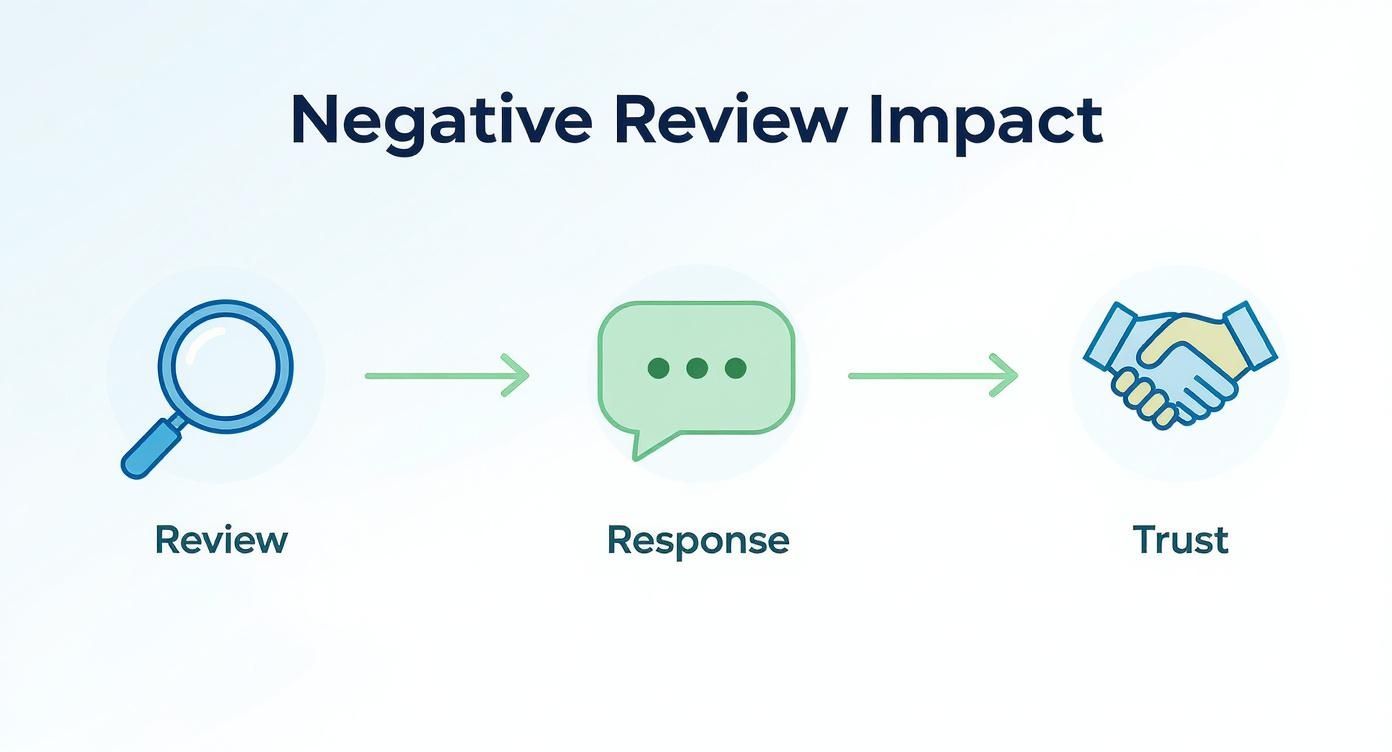Learning how to reply to a negative review is critical because your public response can either win over new customers or drive them away. A prompt, professional reply shows potential customers you're trustworthy and accountable, which builds the confidence they need to call, book an appointment, or visit your location. This simple action directly impacts conversions and protects your bottom line.
Key Facts
- Speed Matters: 53% of customers expect a response to a negative review within 7 days. Your goal should be under 24 hours.
- Perception is Reality: 71% of consumers say they view a business more favorably if it replies to a review.
- Revenue is at Stake: 94% of consumers report that a negative review has convinced them to avoid a business.
- SEO Impact: Replying to reviews signals trustworthiness to Google, boosting your local search ranking through its Proximity-Relevance-Prominence model.
Step-by-Step Guide: How to Reply to a Negative Review
Knowing you need to reply is one thing; knowing how to do it without making things worse is something else entirely. A defensive, emotional response can cause far more damage than the original review. Instead, follow a structured, professional approach to de-escalate the situation and show prospective customers you genuinely care.
This visual breaks down how a thoughtful response can rebuild trust and strengthen your reputation.
Here is a 4-step process that works whether you run a dental practice in [City] or an auto repair shop in the [Neighborhood] area.
Step 1: Acknowledge and Apologize Promptly (Within 24 Hours)
Your first move is to be fast. Aim to reply within 24 hours. Speed sends a powerful message: you're listening, and you take feedback seriously.
Start your response with a simple, direct apology for their poor experience. An apology isn't an admission of guilt. You’re not saying "we messed up." You're saying, "I'm sorry your experience didn't live up to your expectations." It’s an act of empathy that immediately lowers the temperature.
Example: "Hi [Customer Name], thank you for sharing this with us. I'm truly sorry to hear that your recent visit wasn't the experience you expected."
Step 2: Restate the Issue and Take Ownership
Next, show them you actually read the review. Briefly mention the core issue they brought up. This validates their feelings and proves you’re not just sending a canned response. Whatever you do, don't make excuses or blame a team member. As the owner or manager, the buck stops with you.
- Avoid: "Our new receptionist wasn't familiar with the policy."
- Say Instead: "We apologize for the miscommunication regarding our billing policy. I can understand how frustrating that must have been."
Step 3: Explain the Resolution and Move the Conversation Offline
After owning the problem, briefly touch on what you're doing to fix it. You don't need a detailed breakdown; just focus on the resolution as it relates to them. This is the most critical part: invite them to continue the conversation privately. This protects their personal information (PHI) and prevents a public back-and-forth. Always provide a direct contact name, email, or phone number.
Example: "We're reviewing our check-in procedures to ensure this doesn't happen again. I'd appreciate the chance to discuss this with you directly. Please call me at [Phone Number]. – [Your Name], Practice Manager."
Step 4: Boost Your Local SEO with Review Engagement
Engaging with reviews impacts your local search ranking. Google’s algorithm uses Proximity, Relevance, and Prominence to rank businesses.
- Proximity: How close you are to the searcher (e.g., "HVAC repair near me").
- Relevance: How well your Google Business Profile matches the search.
- Prominence: How well-known your business is. Reviews are a massive part of this.
Replying to reviews builds trustworthiness, a key component of prominence. Google sees an active, responsive business as more credible, which helps you rank higher in local search results and the Google Maps Pack. For a deeper dive into this, see how you can optimize your Google Business Profile.
Templates & Scripts You Can Use Today
Having go-to scripts saves time and ensures a consistent, professional tone. Here are some compliant, real-world templates for common verticals.
Review Request Scripts
-
SMS Request (Vet Clinic):
Hey [Pet Parent Name], it was great to see [Pet Name] at [Clinic Name] today! If you have a moment, we'd be grateful if you could share your experience on Google. Your feedback helps other pet owners in [City] find us. [Link to Google Review]
-
Email Request (Senior Living):
Subject: A quick question about your tour
Hi [Family Member Name],
Thank you for visiting [Community Name] today. We hope we were able to answer all your questions.
When you have a moment, would you mind sharing your thoughts on your experience? Every review helps other families in our community make this important decision.
[Link to Google Review Page]
We look forward to speaking with you again soon.
Sincerely,
The Team at [Community Name]
Review Response Templates
-
Positive Review Response:
Hi [Customer Name], thank you so much for the kind words! We’re thrilled you had such a great experience with [mention a specific service or team member]. It means a lot that you took the time to share this, and we look forward to seeing you again!
-
Negative Review Response:
Hi [Customer Name],
Thank you for sharing your feedback. I'm genuinely sorry to hear that your experience with [mention the service, e.g., 'your AC installation'] didn't live up to expectations.
We always aim to [mention your standard, e.g., 'provide clear communication and top-notch service'], and it's clear we missed the mark here. Your comments are important because they show us where we need to improve.
I'd like the chance to connect with you directly to understand what happened and find a way to make this right. You can reach me personally at [Direct Phone Number] or [Direct Email].
Sincerely,
[Your Name], [Your Title]
This approach is both HIPAA-aware and Fair Housing-neutral, making it a safe and effective starting point. For more detailed breakdowns, you can find more negative review response examples.
How to Measure Your Review Management ROI
Replying to reviews is a marketing investment. By tracking the right numbers, you can draw a straight line from your efforts to more calls, bookings, and revenue.
Key Performance Indicators (KPIs) to Track:
- Review Volume: Target 5-10 new reviews per location, per month.
- Review Recency: Aim for at least 1 new review per week.
- Average Star Rating: Strive for 4.5 stars or higher.
- Response Time: Respond to 100% of negative reviews within 24 hours.
- GBP Views & Calls: Monitor the "Performance" tab in your Google Business Profile for increases in views, direction requests, and calls.
- Lead-to-Sale Conversion: Track how many calls or form fills from your GBP turn into paying customers.
To connect your GBP activity to website leads, use UTM (Urchin Tracking Module) parameters. These are tags added to your website URL in your GBP listing. This allows Google Analytics to show you exactly how many website visits, appointment requests, and calls originated from your profile. When you see these numbers climb after improving your review strategy, you've got proof of your ROI. This is a core part of effective reputation management.
7-Day Launch Checklist for a Review Program
- Day 1: Fully optimize your Google Business Profile (all sections complete).
- Day 2: Finalize your SMS and email review request templates.
- Day 3: Train your front-line staff on when and how to ask for a review.
- Day 4: Set up a system to monitor new reviews daily.
- Day 5: Assign one person to be the owner of responding to all reviews.
- Day 6: Send your first batch of review requests to recent happy customers.
- Day 7: Respond to your first incoming reviews using your new templates.
Frequently Asked Questions (FAQ)
1. What if I’m certain a review is fake?
First, flag it within your Google Business Profile dashboard. While you wait for Google's review, post a calm public reply. A good script is: "Thank you for the feedback. We take all customer experiences seriously, but we can't find any record matching these details. Please contact our office directly at [Phone Number] so we can investigate." This shows diligence to real customers without escalating.
2. Should I reply to a negative review that is very old?
Yes, if it's within the last 6 months. Replying shows new prospects that you are now actively engaged and care about feedback, even if you weren't in the past. Keep the response concise and follow the standard 4-step framework.
3. What is the ideal length for a reply to a negative review?
Keep it short: 3-4 sentences is the sweet spot. The goal is to acknowledge the issue and take the conversation offline, not to debate the details publicly. A long reply can appear defensive.
4. Should I ever offer a refund in my public response?
No. Never offer refunds, discounts, or freebies in a public reply. This can encourage others to complain to get a handout and may look like you are trying to "buy" a better review. All compensation discussions should happen privately after you resolve customer complaints and build loyalty.
5. Can I ask a customer to remove their negative review?
Yes, but only after you have completely resolved their issue and they are satisfied. Once you've made things right, you can say, "We're so glad we could resolve this for you. If you feel we've earned it, we'd be grateful if you would consider updating or removing your original review." Ask without pressure.
Managing your online reputation is an ongoing effort that directly fuels your growth. If you need dedicated, month-to-month support to handle your reviews and strengthen your online presence, Book a strategy call with our team today.



